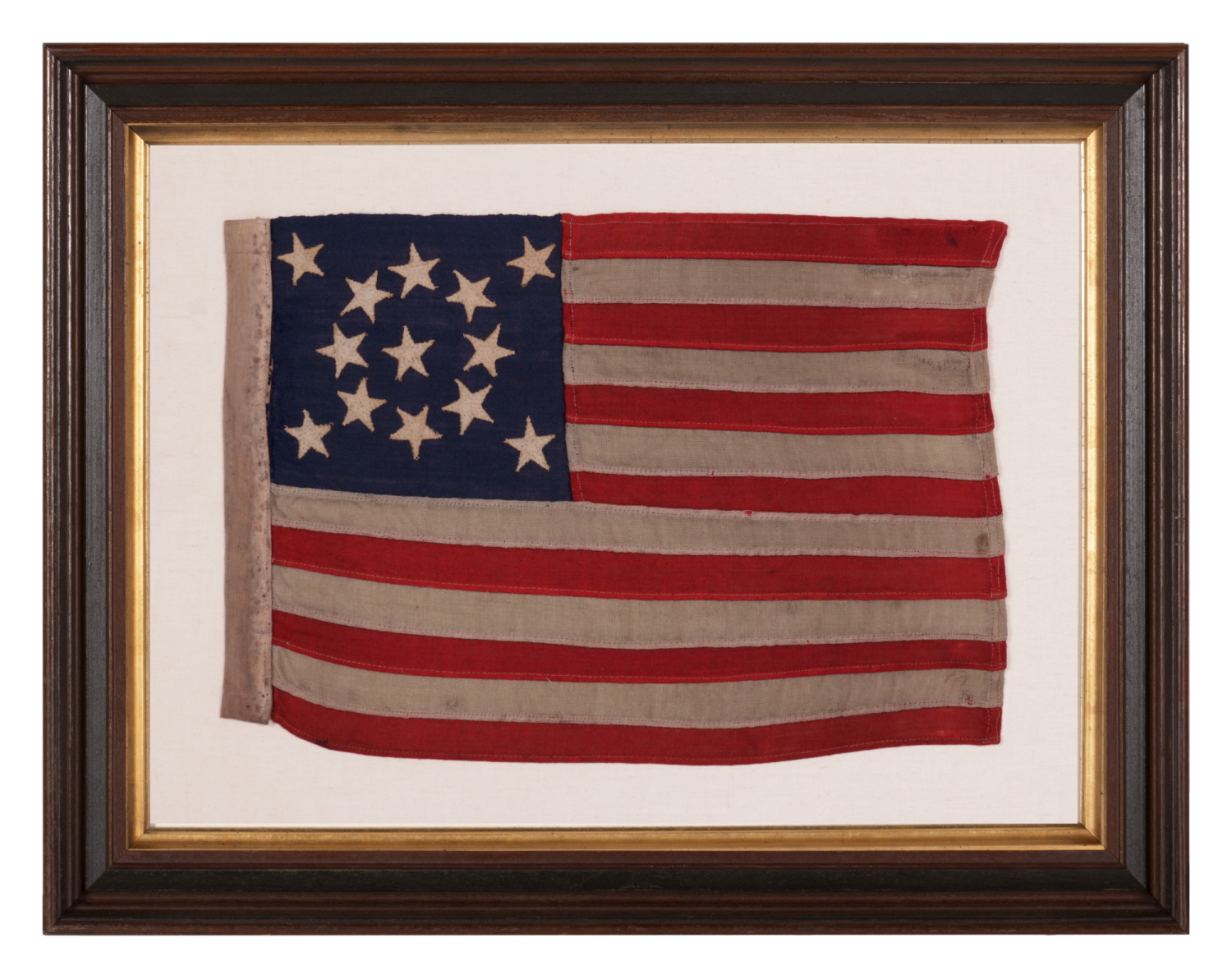


| 13 STAR ANTIQUE AMERICAN FLAG WITH A MEDALLION CONFIGURATION OF STARS; A TINY EXAMPLE AMONG ITS COUNTERPARTS WITH SEWN CONSTRUCTION, MADE circa 1895-1926, EXHIBITED AT THE MUSEUM OF THE AMERICAN REVOLUTION, JUNE-JULY 2019 |
|
| Web ID: | 13j-1534 |
| Available: | In Stock |
| Frame Size (H x L): | 22" x 28" |
| Flag Size (H x L): | 12.5" x 18.5" |
| Description: | |
| This 13 star antique American flag is of a type made during the last decade of the 19th century through the beginning of the 20th. The stars are arranged in a medallion configuration that features a single star in the center, surrounded by a wreath of stars, with a flanking star in each corner of the blue canton. The canton and stripes of the flag are made of wool bunting that has been pieced with treadle stitching. The stars are made of cotton and are double-appliquéd (applied to both sides) with a zigzag machine stitch. There is a twill cotton binding along the hoist, in the form of an open sleeve. Why 13 Stars? As the number of stars grew with the addition of new states, it became more and more difficult to fit their full complement on a small flag. The stars would, by necessity, have to become smaller, which made it more and more difficult to view them from a distance as individual objects. The fear was that too many stars would become one white mass and distort the ability to identify American ships on the open seas. The U.S. Navy used 13 stars on its small-scale flags for precisely this reason. This was, of course, the original number of stars on the first American national flag, by way of the First Flag Act of 1777, and equal to the number of original colonies that became states. For all practical purposes, commercial flag-makers simply didn't produce flags with pieced-and-sewn construction that were 3 to 4 feet in length before the 1890's. There are exceptions to this rule, but until this time, the smallest sewn flags were typically 6 feet on the fly. The primary use had long been more utilitarian than decorative, and flags needed to be large to be effective as signals. Private use grew with the passage of time, however, which led to the need for long-term use flags of more manageable scale. Beginning around 1890, flag-makers began to produce small flags for the first time in large quantities, namely with dimensions of 2 x 3 feet or 2.5 x 4 feet. At just 1 x 1.5 feet, this is a tiny example among its counterparts. Applying the same logic as the U.S. Navy, they chose the 13 star count rather than the full complement of stars for sake of ease and visibility. Any flag that has previously been official remains so according to the flag acts, so 13 star flags remain official national flags of the United States of America. The 13 star count has been used throughout our nation's history for a variety of purposes. In addition to being flown by the Navy, 13 star flags were hoisted at patriotic events, including Lafayette’s visit in 1824-25, the celebration of the nation's centennial in 1876, and the sesquicentennial in 1926, as well as for annual celebrations of Independence Day. They were displayed during the Civil War, to reference past struggles for American liberty, and were used by 19th century politicians in political campaigning. The use of yachting ensigns with a wreath of 13 stars surrounding a fouled anchor, which allowed pleasure boats to bypass customs between 1848 and 1980, persists today without an official purpose. Provenance: This flag was presented from June 14th – July 21st at the Museum of the American Revolution in Philadelphia, in an exhibit entitled “A New Constellation,” curated by Jeff Bridgman. This was the first ever, large scale exhibit of 13 star examples at a major museum. Mounting: The flag was mounted and framed within our own conservation department, which is led by expert staff. We take great care in the mounting and preservation of flags and have framed thousands of examples. The flag has been hand-stitched to 100% hemp fabric or a hemp and cotton blend (we use both interchangeably). The solid walnut frame dates to the period between black-painted and hand-gilded molding with its wide, shaped profile, is Italian. The glazing is U.V. protective acrylic (Plexiglas). Feel free to inquire for more details. Condition: There is minor mothing in limited areas, accompanied by modest to moderate areas of the same in the 2nd and 4th white stripes, near the fly end, and along the canton, on the hoist end. Fabric of similar coloration was placed behind these areas, for masking purposes, during the mounting process. There is significant soiling along then entire length of the hoist binding. There are minor stains in the 1st and 2nd stripes, near the fly and hoist ends, respectively, and near the fly end of the 8th stripe. Many of my clients prefer early flags to show their age and history of use. |
|
| Video: | |
| Collector Level: | Intermediate-Level Collectors and Special Gifts |
| Flag Type: | Sewn flag |
| Star Count: | 13 |
| Earliest Date of Origin: | 1895 |
| Latest Date of Origin: | 1926 |
| State/Affiliation: | 13 Original Colonies |
| War Association: | |
| Price: | Please call (717) 676-0545 or (717) 502-1281 |
| E-mail: | info@jeffbridgman.com |
 |
|